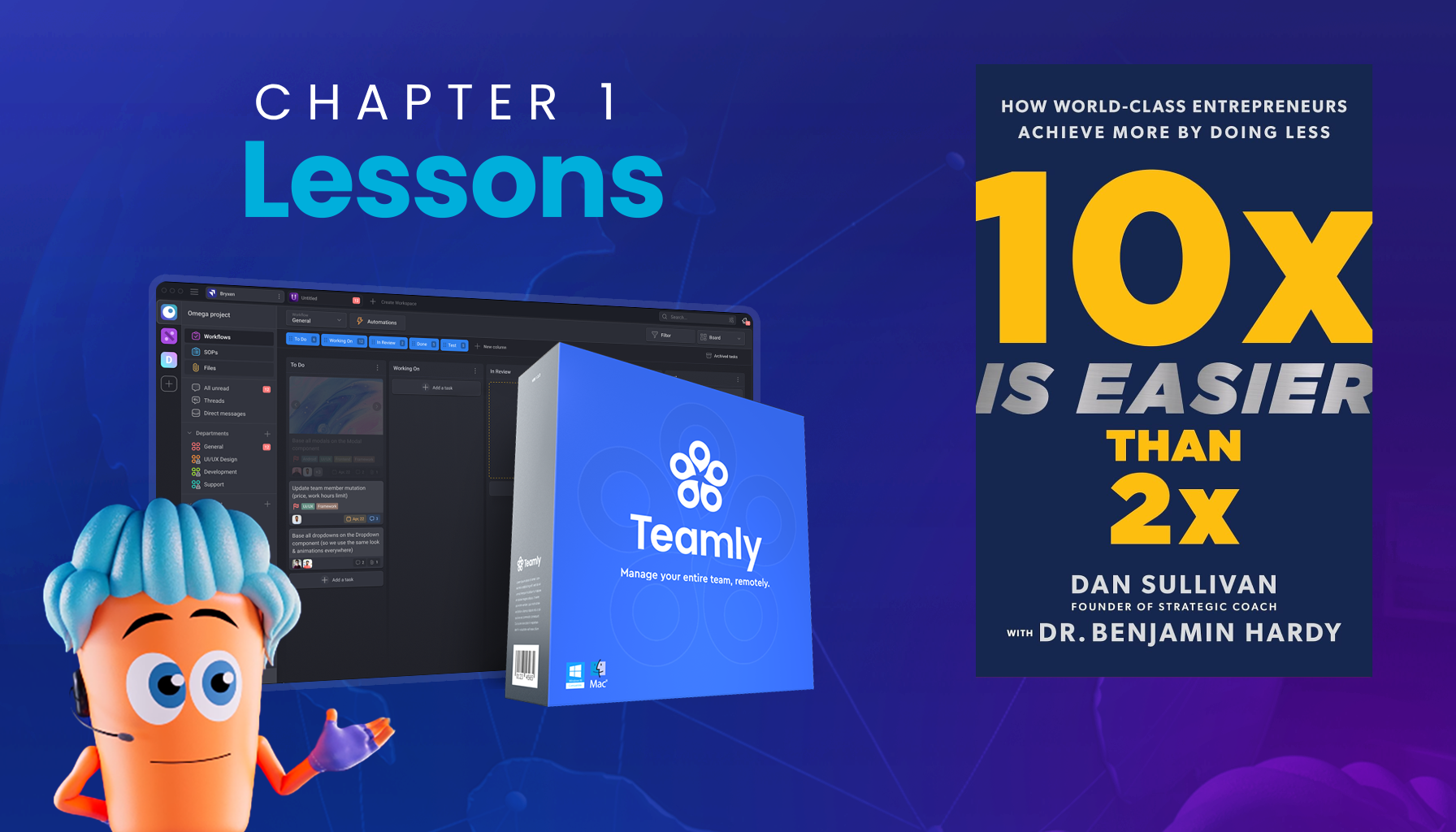
Click the button to start reading
Chapter 1 Insights: 10x Is Easier Than 2x
10x Is Easier Than 2x, authored by Dan Sullivan and Dr. Benjamin Hardy, takes an intriguing stance: the most significant leaps in growth don’t come from incremental, linear efforts.
Instead, real progress emerges from adopting a bold, exponential mindset. The book’s opening chapter illustrates how aiming for 10x transforms leaders, entrepreneurs, and their organizations in ways that doubling growth never could.
The stories of individuals like Carson, who revamped a logistics company by specializing in high-stakes deliveries, and Linda McKissack, who grew from a struggling agent to a regional real estate empire builder, showcase that “letting go of the 80%” can unlock opportunities most leaders overlook.

The Carson Case Study: Stream Logistics
One of the most compelling examples in Chapter 1 is Carson, the co-founder of Stream Logistics.
When he first set out to grow his company, he tried the common route of signing as many clients as possible, hoping that more volume would translate to more profit.
However, the outcome was startlingly difficult: dividing attention across many clients meant juggling a massive workload with diminishing returns. This is a classic illustration of the “2x mindset,” where more work equals a bit more progress—but it also equals a lot more stress.
The turning point occurred when Carson realized he could dramatically boost profitability by targeting a niche with high-level needs.
He identified “High Stakes Freight,” a specialty where clients require speed, security, and precision in logistics, and are willing to pay a premium. This decision might sound risky—fewer clients, a narrower focus—but it led to an exponential payoff.
Freed from the minutiae of lower-margin work, Carson devoted his energy to refining a service that met specialized demands.
The results were astonishing: Stream Logistics quadrupled its profitability while managing fewer, more valuable accounts.
The key insight? Chasing smaller but more rewarding opportunities can fuel a 10x growth trajectory.
This counters the belief that bigger must always mean broader. When the team specialized in a very specific corner of the market, they elevated their expertise, fine-tuned processes, and developed a reputation for excellence in that niche.
In doing so, they set themselves apart from the sea of generalist logistics providers competing on price rather than on specialized value.
Carson’s story underscores that 10x thinking isn’t about trying harder or longer; it’s about letting go of the 80% that doesn’t drive results.
By embracing a specialty, Carson avoided an unmanageable workload and discovered a simpler, more profitable path to exponential growth.

Linda McKissack’s Journey: From Agent to Regional Leader
Linda McKissack’s trajectory is an even more striking example of this principle. She started out facing significant financial struggles, searching for a viable means to make a living.
Her first foray into real estate was by necessity rather than passion. However, as soon as she began seeing success, her perspective on the industry underwent a profound shift.
Linda realized that if she could handle the day-to-day tasks more effectively—by hiring “Whos” to manage them—she could focus on high-impact projects that would push her career to the next level.
Early in her real estate career, Linda made a decisive move: she hired an assistant. It may not sound like a 10x leap at first, but for Linda, it was transformative.
Removing the burden of administrative tasks freed her to spend time where she excelled most—prospecting, marketing, and client engagement. As her workload became more balanced, her sales soared.
She quickly became a top listing agent in her area, fueling what would become the first of several 10x transformations.
Another major leap came when Linda discovered the power of franchising. She dove into ownership with Keller Williams, eventually expanding her portfolio to multiple states.
Each subsequent step up the ladder in her real estate empire required learning how to delegate even more tasks. In doing so, Linda remained laser-focused on her “20%”—the small fraction of responsibilities that drove the greatest results.
Throughout these phases, Linda encountered pushback: from traditional brokerage firms, from skeptical peers, and even from her own internal doubts.
But by systematically reducing the distractions of the 80% that don’t move the needle and entrusting that work to highly competent teams, she created a thriving business model.
By the time she reached her regional leadership position, Linda’s ventures were not just incremental successes; they were exponential leaps.
And the story doesn’t end there—her approach to growth, which involves building a reliable culture and identifying new investment opportunities, keeps propelling her forward.

The Principles of 10x Growth
Qualitative vs. Quantitative Gains
The distinction between aiming for 2x and aiming for 10x lies in the difference between quantitative and qualitative goals.
Aiming for 2x often involves doing more of what already works: more marketing spend, more client calls, more operational hours, more hustle. Yet this approach can lead to a plateau because the mental bandwidth of a leader and the operational capacity of a team get stretched thin.
In contrast, the 10x mindset calls for narrowing in on a specialized approach or reevaluating an entire business strategy to focus on high-leverage activities. In both Carson’s and Linda’s journeys, the secret was in doing less but doing it better. They identified narrower paths with greater rewards, effectively “going deep” instead of “going broad.”
Letting Go of the 80%
Both stories highlight the power of letting go of the 80% of tasks, clients, or opportunities that yield minimal returns.
For Carson, this meant stepping away from low-margin freight operations. For Linda, it was handing off administrative duties and lesser roles to trusted assistants or staff.
This isn’t just about outsourcing tasks; it’s about making room for game-changing insights, higher-value deals, and more meaningful client engagements.
When the 80% is set aside, energy can be redirected toward the 20% that genuinely fuels growth.
Many professionals cling to tasks they believe only they can do, but in reality, delegating them can open up mental and emotional space for strategic thinking and innovation.
Who Not How
A theme repeated throughout 10x Is Easier Than 2x is leveraging the power of “Who Not How.” Instead of asking, “How will I accomplish all these tasks?”
Linda and Carson each found their answer in “Who can best handle these tasks so I can focus on my core strengths?” It’s a mindset shift that can produce dramatic improvements in performance, morale, and business health.
Linda’s journey is a testament to this principle. By incrementally building a robust team of “Whos,” she systematically offloaded the 80%.
This freed her to develop scalable systems, build more franchises, and eventually mentor others. In that sense, the “Who Not How” approach is a scalable model—each new hire amplifies the leader’s effectiveness.

Overcoming Resistance to Change
Any significant shift in strategy or focus is bound to face friction. Carson’s move to specialize in High Stakes Freight initially left some colleagues uneasy. Shouldn’t a logistics company diversify its clientele to minimize risk? Yet he discovered the opposite: by concentrating on a distinct market, the risk of trying to serve everyone was actually reduced.
Linda ran into organizational barriers when she wanted to scale further. Traditional brokerages had rigid frameworks that limited her earning potential.
She also encountered personal limitations—self-doubt and uncertainty about her next big leap. The book points out that true 10x growth often stirs skepticism in others, making it crucial for leaders to remain steadfast in their vision.
Whether it’s resistance from a team or concerns from upper management, the path to 10x can look risky to those who haven’t fully embraced the concept. The authors encourage entrepreneurs to persist through this stage, using clear communication and proven results to win over stakeholders.
Transformational Leadership and Culture
A deeper look at Linda’s success reveals something crucial: after her second or third significant jump, she had to evolve from being simply an effective salesperson to becoming a transformational leader.
Yes, delegating tasks and leveraging “Whos” is important. But it’s equally pivotal to cultivate an environment where employees share the vision of growth and feel empowered to contribute to it.
For Linda, that meant instilling a culture rooted in growth, mentorship, and relentless learning.
She led by example, showing her teams that 10x growth is not about working to the brink of exhaustion, but about strategic choices. By modeling that focus—and surrounding herself with people who believed in the power of 10x—she created a self-reinforcing cycle of success.
Carson’s leadership transformation ran parallel. As his company specialized, he encouraged a culture of high standards and accountability.
Everyone on the team understood that what they did was mission-critical for the clients who absolutely needed fail-proof logistics.

Takeaways for Leaders and Entrepreneurs
The stories in Chapter 1 illuminate how 10x thinking often requires a strategic shedding of old habits and an embrace of new approaches. Leaders who apply these insights can set themselves up for exponential success:
- Set bold goals that defy conventional limitations. Aiming for 10x can prompt leaders to reevaluate everything from product lines to entire business models.
- Choose specialization over overextension. Carson’s experience highlights the financial and operational advantages of narrowing the focus to a high-value niche.
- Delegate early and often. Linda’s career pivoted on her willingness to trust competent people with significant responsibilities.
- Foster a growth-focused culture. Both Carson and Linda encouraged environments that embraced transformation, making the 10x journey a team effort.
- Leverage “Who Not How.” Seeking out the right team members is often the differentiator between slow, incremental gains and a leap to the next level.
Many entrepreneurs find that implementing the 10x approach is easier with the right tools and systems. Teamly software is a great example of a solution designed to streamline collaboration and delegation, allowing leaders to zero in on their highest-value work.
For those craving more in-depth strategies, insights, and success stories, 10x Is Easier Than 2x offers a clear roadmap.
It gives a behind-the-scenes look at how real leaders made the leap from linear growth to exponential change.
The book has a way of nudging readers to question long-held assumptions about how much effort is really needed, and where that effort should be directed.
Ready to see how these marketing steps come together in a broader framework?
Get it here: 10x Is Easier Than 2x on Amazon.
















